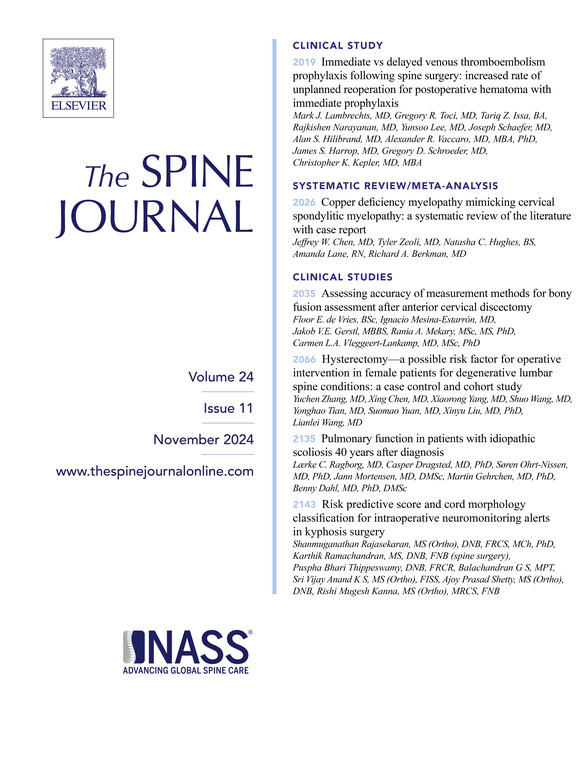Real world clinical outcomes when discontinuing denosumab or bisphosphonates in patients with surgically managed osteoporotic vertebral compression fractures: a population-based cohort study
IF 4.9
1区 医学
Q1 CLINICAL NEUROLOGY
引用次数: 0
Abstract
BACKGROUND CONTEXT
Osteoporotic vertebral compression fractures (OVCFs) are common fragility fractures. Patients who undergo surgical treatment for their initial OVCFs warrant particular attention because there is an elevated risk of subsequent vertebral fractures and other types of fragility fractures. However, the optimal osteoporosis treatment for this specific patient group is less investigated.
PURPOSE
This study compares the risk of subsequent osteoporotic fractures and mortality rate for patients who are initiated with denosumab and bisphosphonates and determines the effect of adherence to treatment.
STUDY DESIGN
Retrospective nationwide cohort study.
PATIENT SAMPLE
A total of 2,858 patients who had surgically-managed osteoporotic vertebral compression fractures.
OUTCOME MEASURES
The risk of osteoporotic fractures, vertebral fractures, nonvertebral fractures and death.
METHODS
This is a retrospective nationwide cohort study that uses the National Health Insurance Research Database. Patients aged ≥50 years who were admitted for surgical interventions for OVCF between 2012 and 2016 and subsequently received denosumab or bisphosphonates for one year were included. Patients were stratified according to their antiosteoporosis medications and adherence to treatment. A multivariable, time-varying Cox proportional hazards model was used to determine the risk of osteoporotic fractures, vertebral fractures, nonvertebral fractures and death.
RESULTS
A total of 2,858 patients were included in this study: 1,123 patients in the denosumab group and 1,735 patients in the bisphosphonates group. Compared to persistent denosumab users, the nonpersistent denosumab users, persistent bisphosphonate users and nonpersistent bisphosphonate users had a greater risk of osteoporotic fractures, with respective hazard ratios of 1.64 (95% confidence interval [CI], 1.16–2.32), 1.74 (95% CI, 1.25–2.42) and 1.53 (95% CI, 1.14–2.06). If osteoporotic fractures were divided into nonvertebral and vertebral fractures, none of the groups exhibited an increased risk of vertebral fractures compared to persistent denosumab users, with an HR of 1.00 (95% CI: 0.54–1.88) for nonpersistent denosumab users, 1.64 (95% CI: 0.96–2.81) for persistent bisphosphonate users and 1.52 (95% CI: 0.95–2.43) for nonpersistent bisphosphonate users. However, there was a significantly greater risk of nonvertebral fracture, with respective hazard ratios of 2.04 (95% CI, 1.33–3.11), 1.80 (95% CI, 1.18–2.76) and 1.56 (95% CI, 1.06–2.27) for nonpersistent denosumab users, persistent bisphosphonate users and nonpersistent users. Noteworthy, nonpersistent denosumab users exhibited a significantly greater risk of mortality than persistent denosumab users, with a hazard ratio of 3.12 (95% CI, 2.22–4.38).
CONCLUSIONS
In terms of patients with OVCFs who require hospitalization and surgical intervention, those who receive ongoing denosumab treatment exhibit less risk of developing subsequent osteoporotic fractures than those who receive bisphosphonates or nonpersistent denosumab treatment. However, discontinuation of denosumab is associated with a significantly increased risk of subsequent fractures and mortality. Therefore, adherence to the treatment is crucial for patients who are initiated with denosumab.
手术治疗的骨质疏松性椎体压缩性骨折患者停用地诺单抗或双膦酸盐时的实际临床结果:基于人群的队列研究。
背景情况:骨质疏松性椎体压缩骨折(OVCF)是常见的脆性骨折。因初次发生 OVCF 而接受手术治疗的患者值得特别关注,因为他们随后发生椎体骨折和其他类型脆性骨折的风险较高。目的:本研究比较了开始使用地诺单抗和双磷酸盐类药物的患者随后发生骨质疏松性骨折的风险和死亡率,并确定了坚持治疗的效果:研究设计:全国性回顾性队列研究:共 2858 名接受过手术治疗的骨质疏松性椎体压缩骨折患者:骨质疏松性骨折、椎体骨折、非椎体骨折和死亡的风险:这是一项利用全国健康保险研究数据库进行的全国性回顾性队列研究。纳入的患者年龄≥50岁,在2012年至2016年间因OVCF入院接受手术治疗,随后接受了一年的地诺单抗或双磷酸盐治疗。根据患者的抗骨质疏松症药物和治疗依从性对患者进行了分层。采用多变量时变Cox比例危险模型确定骨质疏松性骨折、椎体骨折、非椎体骨折和死亡的风险:本研究共纳入了 2 858 名患者:其中,1,123 名患者接受了地诺单抗治疗,1,735 名患者接受了双磷酸盐治疗。与持续使用地诺舒单抗者相比,非持续使用地诺舒单抗者、持续使用双膦酸盐者和非持续使用双膦酸盐者发生骨质疏松性骨折的风险更大,危险比分别为 1.64(95% 置信区间 [CI],1.16-2.32)、1.74(95% CI,1.25-2.42)和 1.53(95% CI,1.14-2.06)。如果将骨质疏松性骨折分为非椎体性骨折和椎体性骨折,与持续使用地诺单抗的患者相比,各组患者发生椎体性骨折的风险都没有增加,HR 为 1.非持续使用地诺舒单抗者的 HR 为 1.00(95% CI:0.54-1.88),持续使用双膦酸盐者为 1.64(95% CI:0.96-2.81),非持续使用双膦酸盐者为 1.52(95% CI:0.95-2.43)。然而,非持续使用地诺单抗者、持续使用双膦酸盐者和非持续使用者发生非椎体骨折的风险明显更高,危险比分别为 2.04(95% CI,1.33-3.11)、1.80(95% CI,1.18-2.76)和 1.56(95% CI,1.06-2.27)。值得注意的是,非持续使用地诺单抗者的死亡风险明显高于持续使用地诺单抗者,危险比为3.12(95% CI,2.22-4.38):就需要住院和手术治疗的OVCF患者而言,与接受双膦酸盐或非持续性地诺单抗治疗的患者相比,接受持续性地诺单抗治疗的患者发生后续骨质疏松性骨折的风险较低。然而,停止使用地诺单抗会显著增加后续骨折和死亡的风险。因此,对于开始使用地诺单抗的患者来说,坚持治疗至关重要。
本文章由计算机程序翻译,如有差异,请以英文原文为准。
求助全文
约1分钟内获得全文
求助全文
来源期刊

Spine Journal
医学-临床神经学
CiteScore
8.20
自引率
6.70%
发文量
680
审稿时长
13.1 weeks
期刊介绍:
The Spine Journal, the official journal of the North American Spine Society, is an international and multidisciplinary journal that publishes original, peer-reviewed articles on research and treatment related to the spine and spine care, including basic science and clinical investigations. It is a condition of publication that manuscripts submitted to The Spine Journal have not been published, and will not be simultaneously submitted or published elsewhere. The Spine Journal also publishes major reviews of specific topics by acknowledged authorities, technical notes, teaching editorials, and other special features, Letters to the Editor-in-Chief are encouraged.
 求助内容:
求助内容: 应助结果提醒方式:
应助结果提醒方式:


